The Remarkable Resilience of the Axolotl: Nature’s Master of Regeneration
The Axolotl’s Journey: A Tale of Resilience and Regeneration
One of nature’s most astonishing creatures is a salamander species known as the Axolotl. This fascinating amphibian possesses the extraordinary ability to regenerate lost body parts—a striking survival strategy that has captivated scientists and nature lovers alike.
Introduction to the Axolotl
The Axolotl, also known as the Mexican walking fish, is not a fish at all, but an amphibian that has skipped the usual metamorphosis stage that transforms a larva into an adult. Inhabiting the lake complex of Xochimilco near Mexico City, these creatures exhibit a phenomenon known as neoteny, which enables them to retain their larval features throughout their lives.
Their appearance is charismatic, with frilly gills protruding from their heads and a smile-like expression that makes them a popular subject in popular culture.

The Science of Regeneration
What sets axolotls apart from other animals is their astounding regenerative capability. An Axolotl can regrow multiple structures such as limbs, tail, heart, and even parts of its brain and spinal cord. This capability has led to extensive research in regenerative medicine, with scientists aiming to unlock secrets that could lead to breakthroughs in human healing.
Regeneration vs. Healing: Unlike humans, who heal wounds by forming a scar, axolotls are able to regenerate without scarring, restoring both form and function to impaired body parts.
Conservation Status: A Species on the Brink
Despite their incredible biological abilities, axolotls face the imminent threat of extinction. The once-vast waters of Xochimilco have diminished and become polluted, posing a significant risk to the axolotl’s habitat. Native species are also threatened by the introduction of invasive species such as the tilapia and perch, which compete for resources and prey on young axolotls.
Conservation efforts are underway, including captive breeding, habitat restoration, and research into their unique biology, which may not only save the axolotls but also advance scientific understanding in the field of regenerative medicine.

The Cultural Significance of the Axolotl
Axolotls hold a special place in Mexican culture, being associated with the god Xolotl, from whom they derive their name. In Aztec mythology, Xolotl was the god of fire and lightning and also a guide for souls to the underworld. Interestingly, the axolotl’s ability to regenerate is seen as a symbol of rebirth and renewal.
A Fascinating Creature for Researchers and Hobbyists
Researchers are not the only ones enchanted by axolotls; these creatures have also become popular exotic pets around the world. Hobbyists are captivated by their otherworldly look and peaceful demeanor. However, it is important to remember that the pet trade, if not managed responsibly, can further endanger the fragile wild populations.
Join the Mission to Save the Axolotl
The story of the axolotl is a striking example of nature’s miracles and the ways in which human activities can put them at risk. By spreading the word, supporting conservation efforts, and choosing pets responsibly, everyone can contribute to preserving this extraordinary species for future generations.
 Join the mission to learn about and protect the axolotl. Embrace the wonder of nature’s master of regeneration, and help ensure that these remarkable creatures continue to thrive both in the wild and in scientific research.
Join the mission to learn about and protect the axolotl. Embrace the wonder of nature’s master of regeneration, and help ensure that these remarkable creatures continue to thrive both in the wild and in scientific research.






